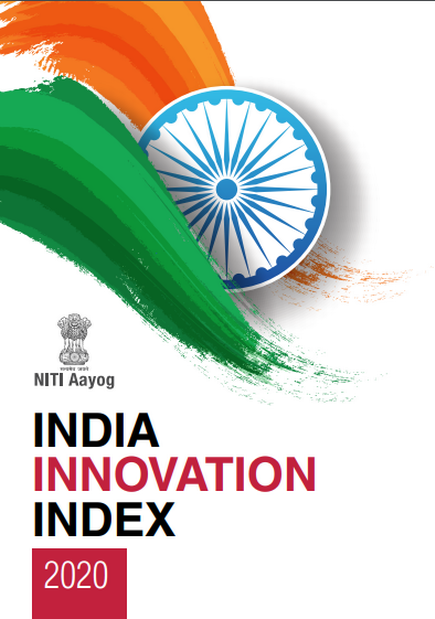
INDIA INNOVATION INDEX 2020: NITI AAYOG
CONTEXT
- Recently, India Innovation Index Report 2020 was released by NITI Aayog in which Karnataka retained its top position in the major States category.
MORE ABOUT INDIA INNOVATION INDEX 2020
-
- The index has been developed on the lines of the Global Innovation Index (GII), to ameliorate the innovation ecosystem of Indian states and Union Territories (UTs) and to design policies to drive innovation across regions.
- he index goes beyond traditional approaches by considering the best parameters in measuring innovation such as patents per million of population, publication in scientific journals, percentage of GDP spending on research.
- It also adds parameters that are specific to the Indian economy (eg. Demographic dividend), to give it a more holistic coverage.
- Indicators Used
-
- Number of PhD students and knowledge-intensive employment.
- Enrolment in engineering and technology and number of highly skilled professionals.
- Investment in R&D and number of patents and trademark applications filed.
- Internet subscribers.
- FDI inflows, business environment and safety and legal environment.
INDIA VS WORLD IN INNOVATION
- Research and Development
- India spends around 0.7% of its GDP on research and development, which is much lower than the top spenders, such as Israel (4.95%), South Korea, Sweden, and Japan.
- In dia lies below other BRICS nations in terms of the percentage of GDP spent on R&D
- Research Per Million Inhabitants in 2018-19
- Another important aspect of R&D is the number of personnel engaged in the process of research itself. This involves the conception and creation of new knowledge, processes, methods, or systems, and the management of projects, which form a crucial part of research and development
- Countries such as Denmark, Sweden, and South Korea have a higher share of researchers in relation to their population. In comparison, India has a much lower share of researchers per million inhabitants.
- National R&D Expenditure by Sector, 2017-18
- In India, the gross expenditure on R&D is primarily driven by the government. The central government holds the largest share at 45% of the total expenditure in 2017-18, followed by state governments at 6.4%. The business sector accounts for 41% of the total share in R&D expenditure
- Countries such as Israel have 88.26% participation of business enterprises in the country’s R&D expenditure, and the United States has 72.57%
UNDERLYING ISSUES AT NATIONAL AND STATE LEVELS
- One of the major challenges observed was regional imbalance with respect to the presence of research institutions in most North-Eastern and Central States.
- Weaker representation of both private and public R&D units shows the inability to tap into the innovative tendencies of these states
- The lack of incubator centres that hurt the growth of young businesses and innovation venture
- Limited grassroots innovations observed across the nation is a major concern. Such innovations have been unanimously acknowledged as a cost-effective route toward sustainable development.
- Need for micro-analysis of State-level policies: For a country as large as India, the state of innovation needs to be understood at the regional level for effective policy formulation.
WAY FORWARD
- To promote business sector R&D, the government could target specific areas under which top R&D-intensive domestic firms are eligible for tax incentives, low-interest loans, and priority procurement.
- The government must consider providing direct R&D grants to companies. This is a deviation from R&D funding mostly going to academic institutions, with the absence of any intention to commercialize innovative concepts. Such practices have been heavily recommended by the US and Israel.
- State Innovation Cells: States are the major source to kickstart any form of grassroots innovation. To achieve the same, special government-backed entities must be established, such as innovation cells.
As India heads into an uncertain future where the global economy is still reeling from the pandemic, innovation holds the key to transition any economy from a developing one toward thedeveloped category
